OKR Vs. KPI: Why & How to Set Goals with Objectives and Key Results
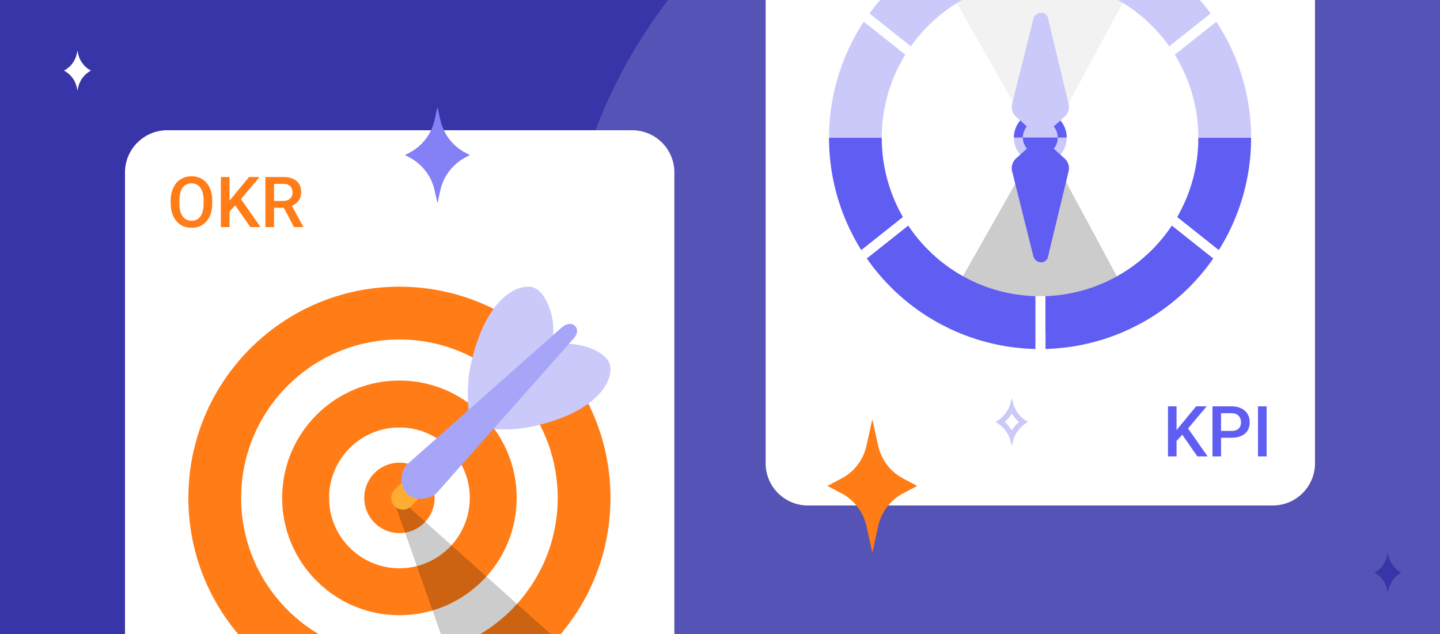
In this article, we’ll tell you what the OKR concept implies, why it is better than KPI, and how to implement the Objective Key Results framework in your team.
When we grew from 10 to 30 people, we got to thinking we became defocused and asynchronous. One part of the team didn’t know what another was doing; we played the Chinese whispers feeling we were heading separately. That’s when we decided to adhere to OKR, and we still do so.
Many product teams have the same problem. Some of them solve it by implementing OKR, others — KPI. Having faced the team focus and synchronization issue in the OKR vs. KPI battle, we joined the first. Namely OKR. Why? We choose to sync people up and help them move in the same direction while meeting their objectives.
After two years in this framework, we’ve got some experience to share:
- How you can implement OKR,
- Why no one can do this right the first time (which is entirely normal),
- And what to do with KPI.
To make this article more insightful, we’ve talked to Ilya, a product & strategy thinking mentor, and discovered his experience implementing OKR in different companies.
Grab your pen and some paper and make notes on the OKR implementation as you read this article.
Check one of the best customer engagement strategies we tested this year.
What is the OKR?
OKR (objectives and key results — KR) is a goal-setting framework helping you determine the direction of your company’s growth, sync teams up, and engage all employees in the process of setting objectives and defining KR.
The objectives are set at these levels:
- Company,
- Teams,
- Particular employees.
These people decompose objectives into measurable results the company wants to achieve. The objective is marked as completed if a specific goal is met.
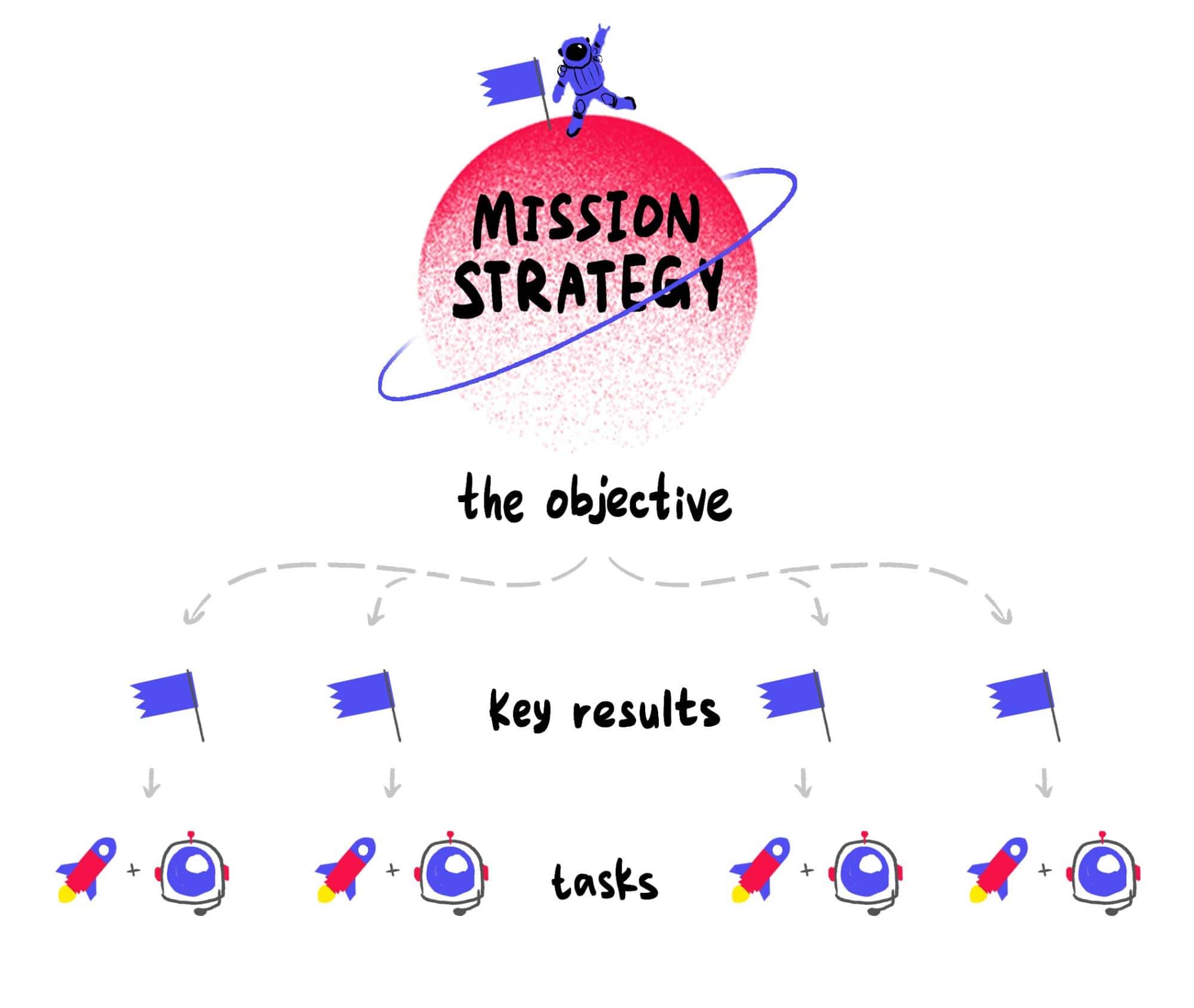
OKRs first appeared in Intel and then moved to Google. John Doer was the one who brought OKRs to Google. You can see him talking about this framework at TED:
Now many high-profile companies like Spotify, Twitter, Airbnb, and Miro use them. It doesn’t mean OKRs can only be applied in the IT universe. You can use them even when planning your own life. I mean it.
For example, my objective for the next two years is to learn French. My KR is to pass DALF for C1 and have 10 Tinder matches with native speakers.
The primary thing about OKR is that top management and the whole company define objectives and key results. That’s why OKRs help you sync up with your team, move in the same direction, and increase each team member’s involvement, as everyone knows how they can influence the achievement of a common objective.
Read also:
👉 How to use lead generation chatbot for your website
👉Lead nurturing platform for your revenue growth
👉 12 types of marketing nurture campaigns
What is a KPI?
The first thing you see comparing OKRs Vs. KPIs is that the last ones focus on metrics that reflect performance. They are indicators that tell if you are meeting company targets or not.
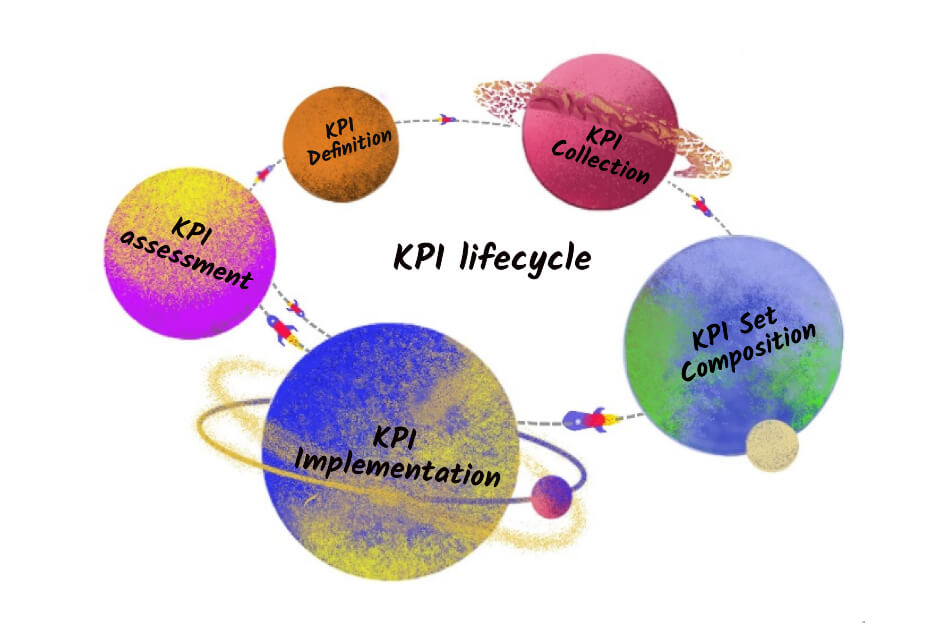
It’s a way of keeping teams accountable and measuring company growth over time.
To perform correctly, KPIs should usually:
- Link to strategic objectives (common feature in OKR Vs. KPI comparison)
- Prioritize resources
- Be measurable
Choosing qualitative KPIs can lead to confusion and subjective data interpretations.
For example, KPI vs. OKR for Sales Department:
- KPI. The number of calls, XXX customer lifetime value, XXX sales revenue. There is a focus on numbers and its 100% implementation.
- OKR. Objective — collect more accurate sales data about leads. KR — build a list of lead metrics and script questions to manage in CRM; 85% of leads answered the obligatory questions.
In the first case, you have numbers. What if they are behind the target? By saying, “time to hit a higher sales revenue goal,” you won’t get sales growth. So what exactly to improve to put everything back on track? One of the solutions we see in OKR is setting an inspiring goal and defining ways to adhere to it.
Read also:
- Attract customers with these 24 ecommerce lead magnets
- The 7 Key Email Marketing Metrics & KPIs You Should Be Tracking
- 13 growth hacking examples tested by Dashly experts [+46 free templates]
OKR VS KPI. Choosing the priority framework
Putting the “versus” between these two is wrong because OKR is for improving your business and goal-setting, and KPI is for monitoring general business performance.
KPIs show the factual situation in numbers. Business uses this data to drive changes with OKRs. Here is a video explaining deeper moments of difference between these two:
There is a good analogy with a road trip in the context of the KPI vs. OKR explanation. Imagine you have to get from Denver to San Francisco. For this, you have a travel guide to strategize the way, a car to drive, and a good GPS to track if you are on the right path.
But sh*t happens. When you’re almost there, a dashboard tells you you’re running out of gas. So you have to adjust the course and stop at the petrol station.
How does this relate to OKR vs. KPI comparison?
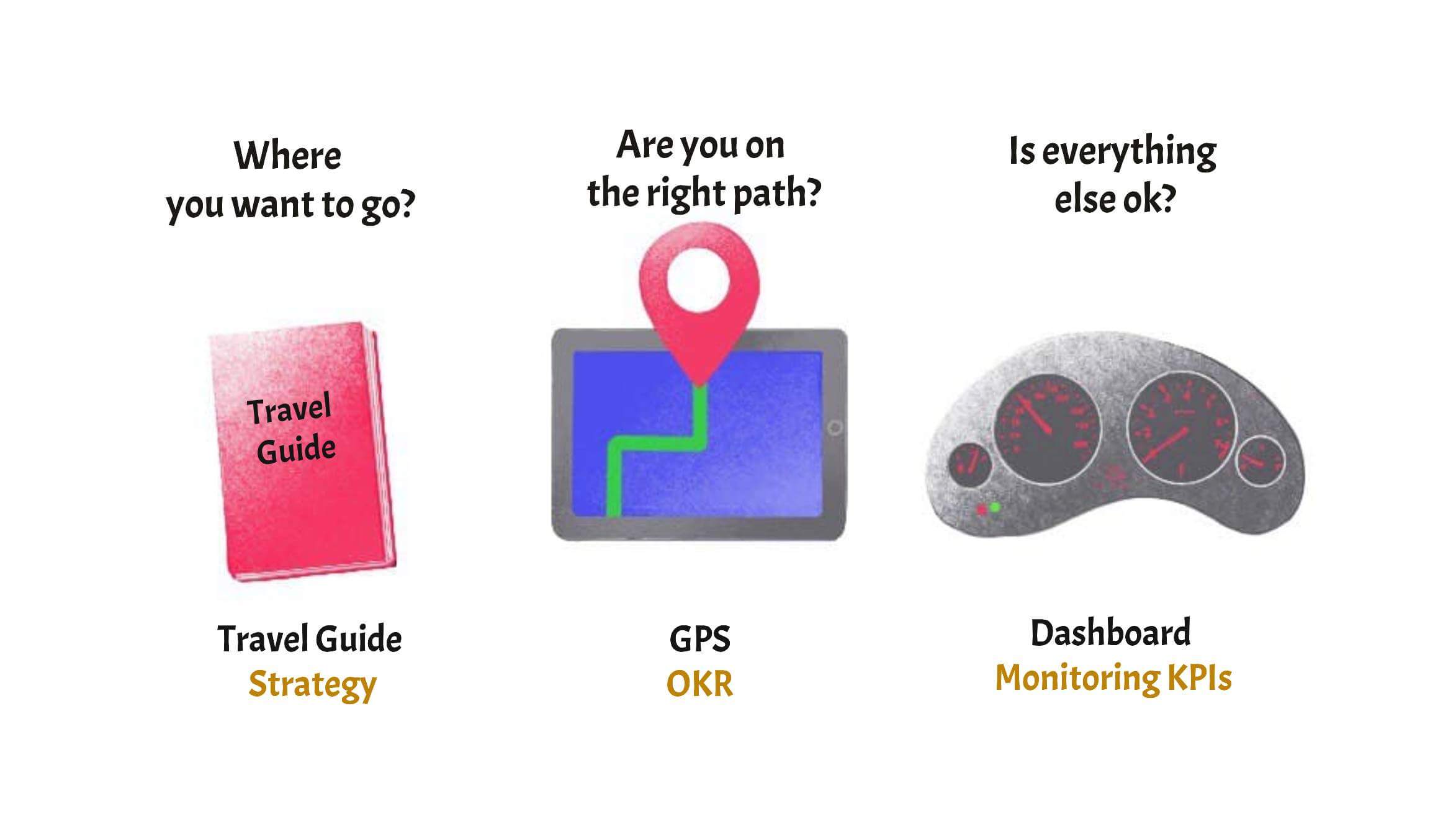
The analogy is simple:
- GPS is OKRs that show if you are on the right path. But it doesn’t formulate the company strategy.
- The dials on your car’s dashboard are Monitoring KPIs — they tell you if everything else is okay.
Let’s see how it works in practice. Examples of OKR vs. Monitoring KPIs:
Case #1 The website brings good traffic. It’s time to improve the conversion rate:
- KR. Conversion rate increase from Y to X
- Monitoring KPI. Website traffic
Case # 2 The app is ready. The team decides to work on customer engagement strategy:
- KR. Increase monthly active users from Y to X
- Monitoring KPI. System Uptime
Read also: What customer engagement platform is best for your business? 15 options to choose.
Case #3 A subscription-based service needs to increase retention:
- KR. Increase retention from Y to X
- Monitoring KPI. New subscribers/month
But even if they work as a single unit, you must choose a priority framework.
Read also:
Sales Funnel Report Templates for Improved Marketing Insights
Top Sales Funnel Automation Tools for 2025
Why OKRs defeated KPIs in Dashly team
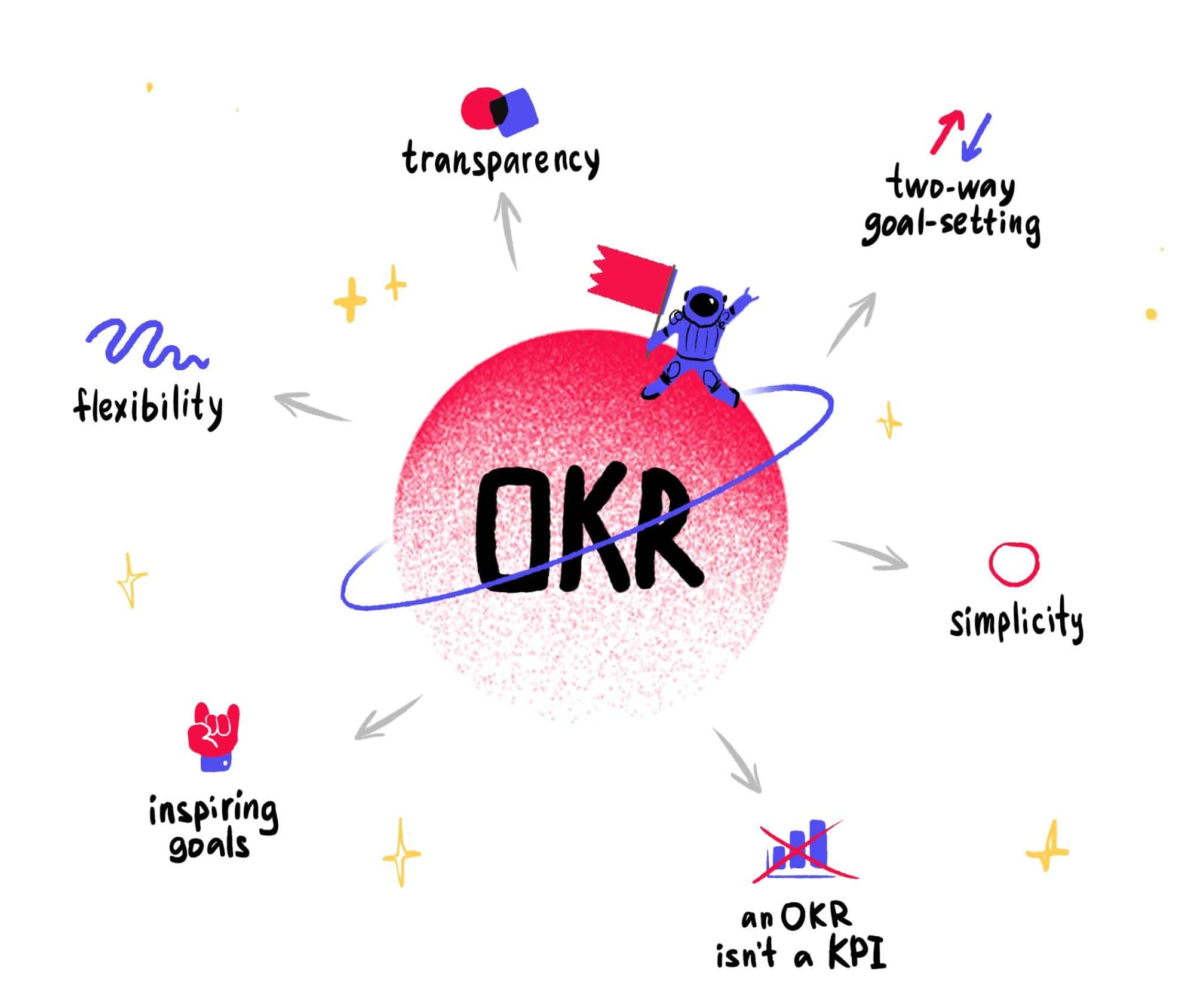
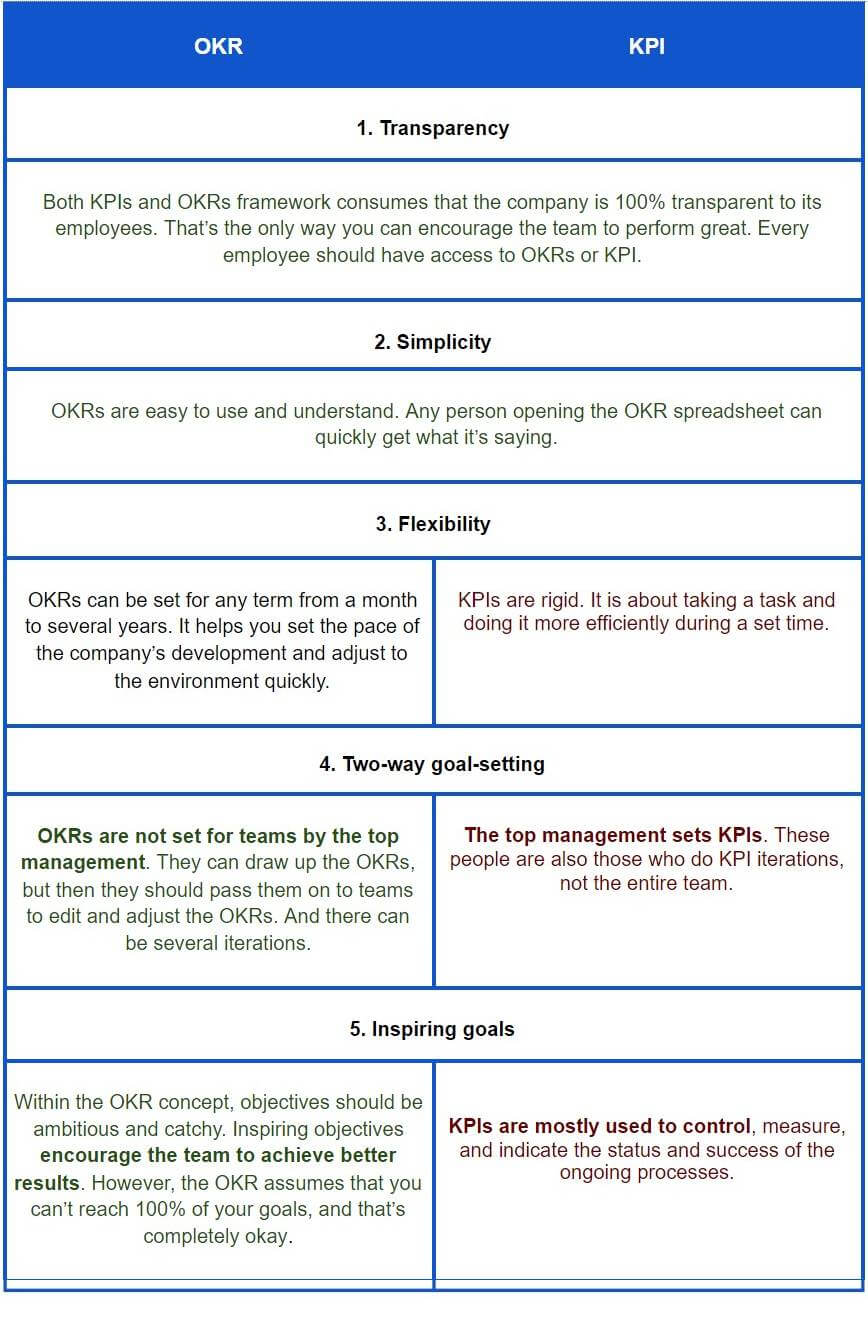
At the finish of the OKR vs. KPI comparison, we have a 4:2 result.
Thus, we chose OKR because this concept fits company values better than KPIs’ one. It doesn’t have an incentive system for achieving objectives. Non-monetary motivation establishes a welcoming environment. So, employees are willing to generate ambitious ideas and have no fear of not meeting the targets.
An OKR isn’t a KPI. There’s no cash bonus for meeting the OKR. The concept is different, and that’s cool. An OKR isn’t something that should be 100% achieved. If we achieve 100% of our OKRs, it means our objectives were not ambitious enough. And vice versa, if we only achieved 30% of our OKRs, it means we’ve set the bar too high. Meeting around 70% of OKRs says we’re doing a great job.
The next question is, how do we define OKR.
Read more
- 10 Best Live Chat Software for Customer Support
- 10 Best Customer Service Chatbot Platforms to Level Up the Work
- How to create a user journey online map for your online school students [4 free templates]
- Increase Customer Support Efficiency With 15 Best Knowledge Base Tools
- Chatbot Guide: What can a chatbot do for your customers 24/7
Objectives, key results, and initiatives
John Doerr’s formula helps you get the difference between these two. As you remember, John Doerr is the person who invented OKR and shared his knowledge with Google. Here’s his formula:

Within the concept, the objective setting relies on its definition and our perception of an achieved objective. The objective should describe the target; the key results are the parameters we will use to determine if we have met the goal. Let’s look closer at the formula:

Key results are an equally important part of the formula. They are decisive in whether an objective has been met or not.
Another way to understand KRs is to ask: “If our goal is X, what will success look like?”
The OKR has an objective that may sound obscure in terms of the result, but it’s powerful and appealing. The second part is the key result. Most often, it’s a specific metric. The key result shows whether the objective has been met or not. If the goal is inspiring, then the KR reflects reality.
What should be the objectives?
Objectives are catchy qualitative descriptions of what we want to achieve. Goals should be concise, ambitious, inspiring, and engaging. They must encourage and challenge the team. In this case, the whole company will have a better chance of achieving tremendous success.
Read also: Capture emails from website visitors with Pop-ups
What are the “key results”?
Key results are parameters that we used to assess how close we have gotten to our objective. Each objective usually involves between 3 and 5 KRs. If you pick more, the teams will find it hard to stay focused. Key results must be quantitative and measurable.
There are two kinds of them:
- Key action-driven result. Success is measured in completed/not completed projects.
- Key value-driven result. Success is measured in the value that the company or customers obtain.
Here are some results of the key action-driven results:
- the chatbot platform launch
- an online course launching
- the OKR book release
Below are some key value-driven results:
- increasing the MRR from X to Y;
- decreasing the Churn rate from X to Y;
- increasing the ER from X to Y;
- maintaining the CAC at around X.
Take a look at the table of key action-driven results and their value equivalents:
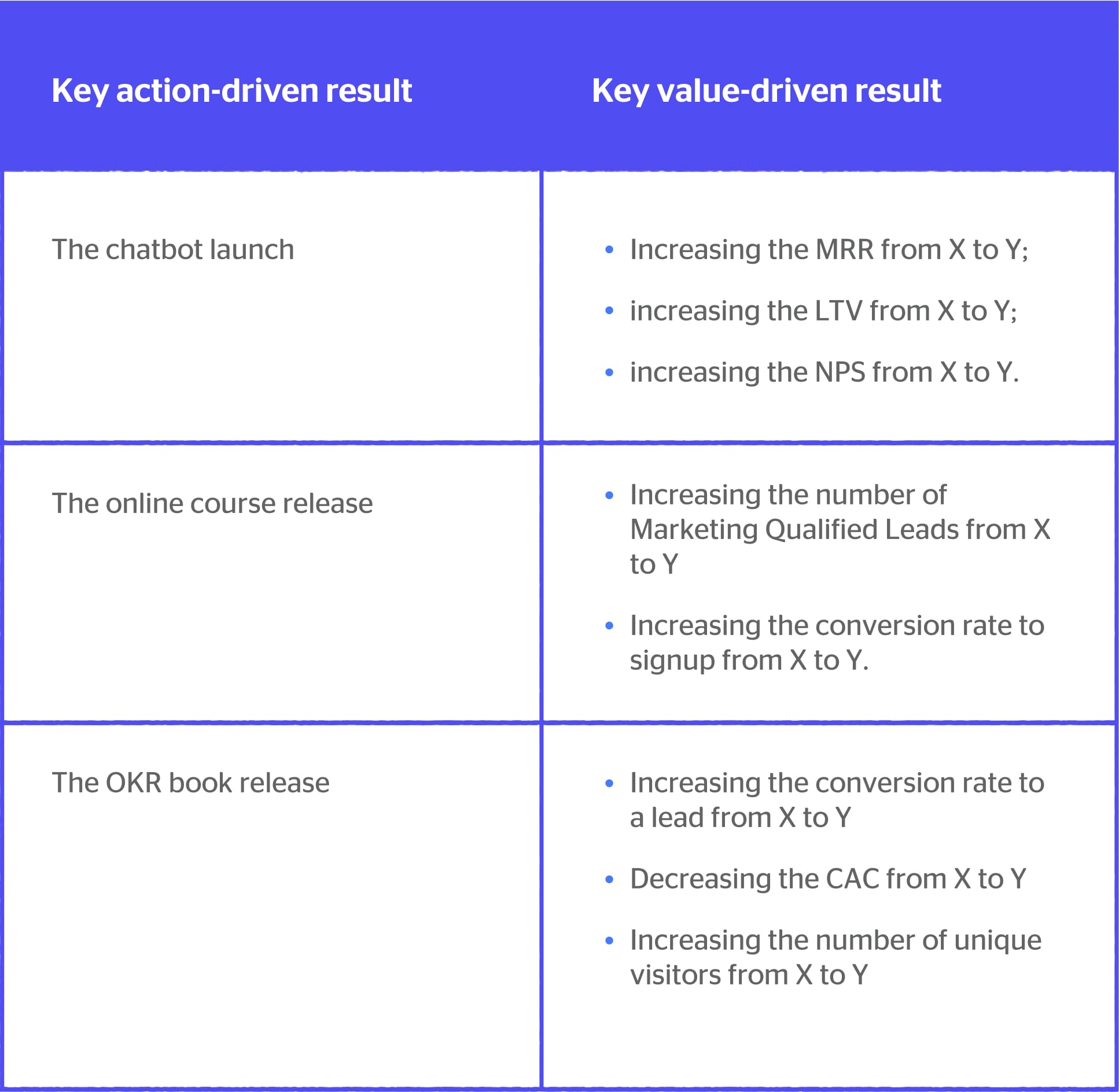
Key action-driven results are highly likely to fail in leading you to an objective. The release of a new feature is not a success guarantee. There is client onboarding left, for example. That’s why OKRs have to be value-driven. Only then can they be as effective as possible.
Key results should reflect the value to the company or its customers. Teams will be focused on achieving greater success and there’ll be more room for creativity. The employees won’t be stuck on a particular activity but will look for different ways to achieve the objective.
Read also: Try user tracking on website to personalise your marketing campaigns.
But if you’re implementing the concept for the first time, choosing actions as key results makes more sense. They will help you to switch to OKR:
Many companies try to add metrics to KRs immediately and fail at this stage. If there was no meaningful movement in the company initially, you’d find it hard to track the metrics.
Many companies try to add metrics to KRs immediately and fail this stage. If there was no meaningful movement in the company at the beginning, you’ll find it hard to track the metrics. First, it’s a good idea to put a set of actions in KRs that we have to perform to get closer to the objective: release a huge feature or a marketing campaign. By the end of the OKR term, you’ll be able to evaluate the success based on the done/not done principle. Another very important point is to only include metrics that we know how to calculate in KRs.
Read also: how to find respondents for a survey or customer interview
How we did it at Dashly
Last year, the goal for OKR in Dashly was to double the number of active users. It’s a catchy and quite ambitious goal, isn’t it?
How do we know if we’ve achieved it or not? We’ve chosen key metric-based results and put all our effort into reaching them and evaluating our success using them.
If objectives are about ambitions, key results must be clear and precise.
The key results for the “doubling” target could be the following:
- Increase the MRR to X: this is our monthly revenue. If we want to grow, we should raise our income, too.
- Reduce the Churn rate to Y. The fewer users leave us, the easier it is for us to grow.
- The CAC must not exceed: this is the Customer Acquisition Cost. If we want to be efficient, we can’t spend more than a certain amount on user acquisition.
- Increase the number of organic visitors to X. The more website visitors we have, the more purchases we generate. It is a great base to find the best way to collect emails.
Read also: The North Star Metric and How Can This Lead to Success
OKR initiatives
Objectives and key results should be value-oriented. So, you must learn not to mix them up with activities and tasks needed to achieve the OKR. Initiatives will help in this.
Initiatives are the activities, tasks, and projects you must accomplish to achieve the OKR.
Let’s get back to our goal of doubling up. We’ve chosen several key results we’ll use to evaluate our success in the future. The KRs are to increase the MRR to X and decrease the Churn rate to Y. And these are the initiatives:
- Launching the chatbot: a vast and fantastic feature that will help reduce customer churn;
- Online course release will help generate new target leads;
- The OKR book release will help increase the number of product sign-ups and product adoption rate.
I think this part is exact. But what should you do with your current KPIs?
Read also: Find out the best Intercom alternatives and Drift alternative
Can KPIs and OKRs co-exist?
The secret to OKRs vs. KPIs — you need both!
Company priorities may change, and your OKRs will represent that. But you regularly track KPI, such as the number of apps installed from your blog. Thus, some KPIs should be abandoned due to irrelevancy, and others will become part of OKR.
Use OKRs for goal-setting and improving your business and KPIs for monitoring general business performance.
To sum up
The KPIs vs. OKRs difference is evident in theory. In the real world, it can be gray areas. A simple nomenclature change can turn a KPI into a KR and vice versa. Just remember that one’s a measurement and the other an outcome. Overlap the wording but not the usage.
OKR is best when you need to improve the overall direction of the startup. KPIs work as a feature, plan, or product performance measurement.
Whatever framework you decide on, Dashly can help you drive it all 👇
Let’s calculate how much extra revenue your business can get with Dashly
Thanks, our manager will contact you soon
It is an updated article that was initially published 2 July 2020.
Read also:
- Customer VS Client — making the difference clear
- Why eCommerce and omnichannel are inseparable?
- How to qualify lead within sales and marketing teams
- Ultimate guide to inbound lead qualification in EdTech marketing
- How to Qualify and Collect More Leads with Lead Bot?
- How BANT sales process can help you get qualified SQL in 2022




![13 growth hacking examples tested by Dashly experts [+46 free templates]](https://www.dashly.io/blog/wp-content/uploads/2023/05/Growth-hacking-examples-to-inspire-your-team-720x317.png)

